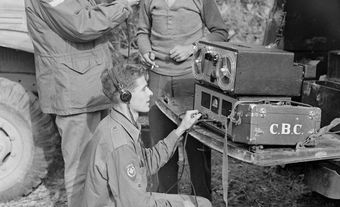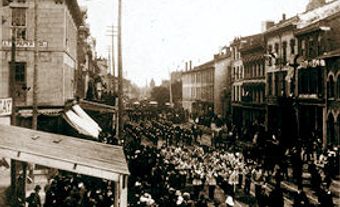Historiography in French
Various descriptive works and narratives dealing with Canada and published in France during the 17th and 18th centuries were entitled "histoires." Although written by Frenchmen who in many cases had only visited New France, these publications profoundly influenced French Canadian historiography. They provided later historians with otherwise unattainable information about events witnessed by their authors, as well as valuable descriptions of the daily lives of colonists and Indians.
One historiographic work of this period stands out from the rest: Histoire et description générale de la Nouvelle France, by the Jesuit P.-F.-.X. Charlevoix (Paris, 1744). Already a published historian, the author stayed in New France 1705-09 and returned 1720-22, when he travelled from Québec down the Mississippi Valley to New Orleans. His abundantly documented Histoire gives a faithful account of political, military and religious events from the early 16th century to 1736. For a century it remained the best history of the French colony.
The Canadiens paid little attention to the historical genre until the early 19th century, when a feeling of French Canadian nationalism developed. The versatile Montréal writer Michel Bibaud brought out Histoire du Canada (3 vols, 1837-78) which had some documentary and literary merit. This conservative author criticized French Canadian nationalists, L.J. Papineau in particular.
The first volume of François-Xavier Garneau's Histoire du Canada, the most important historiographical work ever published in French in Canada, appeared in Québec City in 1845. Two more volumes followed in 1846 and 1848, and the work went through 8 printings in a century. Garneau voiced the ideals that guided French Canadian nationalists until the mid-20th century. He painted vivid accounts of the saga of New France, including the exploits of the explorers and Coureurs de Bois and the work of French missionaries. He celebrated the military deeds of Frenchmen and Canadiens who defended their land against the British and, later, the Americans.
For the Canadiens, the conflict did not end with the Conquest; after 1791 it simply moved indoors to the Parliament. Garneau's vision of a perpetual struggle for survival as the central element of Canadian history has marked all French Canadian historiography until the present day. Garneau disapproved of the Rebellions of 1837 but strongly criticized British policies toward Canadiens. He vigorously denounced the Act of Union as an attempt to destroy the French Canadian nation. A self-taught historian, Garneau made judicious use of official sources and existing publications, and modelled his Histoire on the works of his favourite author, French historian Augustin Thierry, who held that racial antagonism was the driving force of history.
Garneau showed French Canadians the power of history as an element of national identity. Those who came after him, proponents of the conservative ideology that dominated Québec from the mid-19th century to the 1960s, produced a host of historical works exalting the national and religious past of the people. In their syntheses and monographs, priest-historians Jean-Baptiste-Antoine Ferland, Étienne-Michel Faillon and Henri-Raymond Casgrain stressed the role of the great religious figures of New France.
Such accounts complemented Garneau's works which, in the opinion of the clergy, had been unduly secular. Several works stand out in the abundant historical literature of the last half of the 19th century, among them Joseph-Edmond Roy's Histoire de la seigneurie de Lauzon (5 vols, 1897-1904), which is still instructive reading.
Two historians dominated the first half of the 20th century: Thomas Chapais and Abbé Lionel Groulx. Chapais established himself with biographies of key figures in New France - Intendant Talon and General Montcalm. But his greatest work was Cours d'histoire du Canada (8 vols, 1919-34). The Cours, originally given as a series of public lectures at Université Laval, covered the period from the Conquest to Confederation.
Chapais took up Garneau's Histoire in more rigorous fashion, and had the advantage of fuller documentation. He and his contemporaries benefited from the creation of the National Archives in Ottawa. Chapais's Cours is still a mandatory reference work for any student of political and parliamentary history of that era. Other writers, the most famous being Groulx, opposed his criticism of the Patriotes and his sympathy for British policies.
In 1915 Groulx inaugurated the chair in Canadian history at the Montréal campus of Université Laval (later U de Montréal). In a few years he became the leading historian of French Canada, the only one whose name could rival Garneau's. Each of his books sparked passionate discussion in French Canadian intellectual circles. His synthesis of Garneau's nationalist ideal with traditional Catholic ideology has never been bettered. Histoire du Canada français depuis la découverte (4 vols, 1950-52) is an excellent summary of Groulx's work.
Gustave Lanctot, a career archivist with the NAC, was a less outstanding writer than Groulx, but still admirable for his time. His most important work was a 3-volume study of the French regime, Histoire du Canada (1959-64). The most prolific French Canadian historian was Robert Rumilly, primarily known for his monumental 41-volume account of the years between 1867 and 1945, Histoire de la Province du Québec (1940-69). Anecdotal, written in popular style and drawn largely from printed primary sources such as newspapers, Rumilly's Histoire is still the starting point for any study of the period. Rumilly was also interested in the history of the Acadians and the Franco-Americans.
French Canadian historiography took a new direction after WWII. In 1947 departments of history were created at the universities of Laval and Montréal, modelled on history departments in European and American universities and staffed by professors trained in the methods of professional historiography: Guy Frégault and Michel Brunet in Montréal, and Marcel Trudel in Québec City. Large numbers of students entered history departments in the 1960s, a movement that resulted in more professors, more graduate theses and more publications.
The 1970s saw the creation or further expansion of departments of history at U of Ottawa, U of Sherbrooke, and U du Québec in Chicoutimi, Trois-Rivières, Rimouski and Montréal. History, which had been the preserve of amateurs and a very few university trained scholars before 1945, had in a quarter-century become a major discipline in universities and research institutes. The vitality of the profession in Québec is reflected in the conferences of the Institut d'histoire de l'Amérique française (fd 1946), a gathering of historians whose specialty is the history either of Québec or of Francophones originating there.
These annual conferences constitute the province's best forum for Québec historiography, and their methodological and ideological horizons are constantly being enlarged. The Institut publishes the Revue d'Histoire de l'Amérique Française, which has become the most notable journal for scholarly publications on the history of Québec and French Canada. Other periodicals, such as Histoire sociale/Social History (fd 1968 in Ottawa), also publish articles by historians who are studying Québec with new methodologies developed in France, Britain or the US.
Several works stand out from the mass of material that has been published since 1945. Groulx's disciples, unconcerned with religious ideology, developed strong political positions in their historical works: the writings and teachings of Maurice Séguin and Michel Brunet, for example, largely shaped the thinking of the sovereignty movement of the 1960s. The appearance of history as a university discipline led to greater critical rigour in historical works; the abundant and methodical writings and teachings of Marcel Trudel illustrate this development.
But the impact of the social sciences on historiography since the 1960s has been especially fruitful. Fernand Ouellet's Histoire économique et sociale du Québec, 1760-1850 (1966) was a major event in Québec intellectual life. Ouellet integrated economic and social factors much more firmly than did anyone before him, and drew perceptive conclusions which played down the Conquest as an explanation for French Canadian economic inferiority. He subsequently refined his model, provoking fruitful debates with fellow historians such as Jean-Pierre Wallot. Louise Dechêne's Habitants et marchands de Montréal au XVII siècle (1974) is another example of historical work based on today's best historiographical methods.
PIERRE SAVARD
Historiography in French Since 1970
Since 1970 French Canadian historiography has found itself both continuing and breaking with what has gone before. Earlier gains have remained important, but at the same time - undoubtedly reflecting the changes in contemporary Québec - historiography now presents a new image of Québec. While formerly the unique nature of the Québec historical experience (especially the French Canadian experience) was emphasized, the most recent works show a clear tendency to emphasize similarities between Québec's evolution and those of other societies.
Thanks to social history pioneers, the political and nationalist preoccupations which characterized most earlier historical works have now been joined by economic, social and cultural considerations. The history of a nation which used to be described in terms of harmony, continuity and homogeneity is gradually evolving into a history of a more diversified and conflictual community which, with varying degrees of ease, welcomes change.
The extension of the university network has caused an explosion in the number of professional historians. Many people working in other social science disciplines now write history as well. Historians have been enriched by their involvement with geographers, sociologists, economists, political scientists, anthropologists and demographers. It should also be noted that the research and teaching of history is now very largely in the hands of lay people.
Today the practice of history is characterized by group effort. Some major studies have been undertaken by multidisciplinary research teams, such as the one studying the history of the Saguenay region. Similarly, specialist teams are studying the history of the Mauricie, of women, of workers and the business world, and of books and printing, just to give a few examples. The publication of collective works is common, and many articles and books are jointly signed by 2 or 3 authors.
The production of francophone Canadianist historians remains largely centered in Québec or in French Canada, while English Canadian historians take more interest in the history of Québec. Nevertheless, there is now more contact between the 2 historiographies than there used to be, and more interest in recent periods.
Recent historiography parallels the greater pluralism of present-day Québec by offering a range of ideological points of view. Professional history is now marked also by its desire to understand the historic evolution of society as a whole. Social history is being energetically pursued, especially in new fields of study such as the history of women, the history of labour, demographic history, and rural, urban and regional histories.
Social history is also revitalizing the older fields of study: economic history now stresses socioeconomics; the history of ideas has become the history of ideologies; and political history spends less time on the lives of outstanding politicians in order to concentrate on how they relate to their parties, to the state and to society.
These changes are being accommodated even in the most venerable of the specialized historical reviews, such as the Canadian Historical Review and the Revue d'histoire de l'Amérique francaise, as well as in new ones such as Social History/Histoire sociale, Labour/Le Travailleur (fd 1976) and Urban History Review/Revue d'histoire urbaine. Masters' papers and doctoral theses are more numerous than ever; the annual meetings of the Learned Societies and various conferences spread word of the new studies.
With new and age-old topics of study, new questions and improved methodologies, French Canadian historiography is in full ferment. However, this often exciting history is still young. As always, some poorer works are appearing along with the superior ones. Yet the most striking fact remains that unlike earlier periods, it becomes harder and harder to identify particular leaders. Or perhaps it is just that Québec now has dozens of good historians.
FERNANDE ROY
See also Historiography; Historiography in English.
Authors contributing to this article:

 Share on Facebook
Share on Facebook Share on X
Share on X Share by Email
Share by Email Share on Google Classroom
Share on Google Classroom


